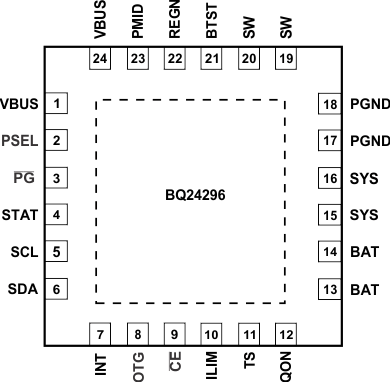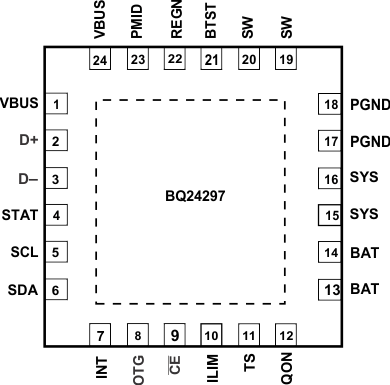SLUSBP6D september 2013 – april 2023 BQ24296 , BQ24297
PRODUCTION DATA
- 1 Features
- 2 Applications
- 3 Description
- 4 Revision History
- 5 Description (continued)
- 6 Device Comparison Table
- 7 Pin Configuration and Functions
- 8 Specifications
-
9 Detailed Description
- 9.1 Overview
- 9.2 Functional Block Diagram
- 9.3
Feature Description
- 9.3.1 Device Power Up
- 9.3.2 Power Path Management
- 9.3.3 Battery Charging Management
- 9.3.4 Status Outputs ( PG, STAT, and INT)
- 9.3.5 Protections
- 9.4 Device Functional Modes
- 9.5 Programming
- 9.6
Register Map
- 9.6.1
I2C Registers
- 9.6.1.1 Input Source Control Register REG00 [reset = 00110xxx, or 3x]
- 9.6.1.2 Power-On Configuration Register REG01 [reset = 00011011, or 0x1B]
- 9.6.1.3 Charge Current Control Register REG02 [reset = 01100000, or 60]
- 9.6.1.4 Pre-Charge/Termination Current Control Register REG03 [reset = 00010001, or 0x11]
- 9.6.1.5 Charge Voltage Control Register REG04 [reset = 10110010, or 0xB2]
- 9.6.1.6 Charge Termination/Timer Control Register REG05 [reset = 10011010, or 0x9A]
- 9.6.1.7 Boost Voltage/Thermal Regulation Control Register REG06 [reset = 01110011, or 0x73]
- 9.6.1.8 Misc Operation Control Register REG07 [reset = 01001011, or 4B]
- 9.6.1.9 System Status Register REG08
- 9.6.1.10 New Fault Register REG09
- 9.6.1.11 Vender / Part / Revision Status Register REG0A
- 9.6.1
I2C Registers
- 10Application and Implementation
- 11Power Supply Recommendations
- 12Layout
- 13Device and Documentation Support
- 14Mechanical, Packaging, and Orderable Information
Package Options
Mechanical Data (Package|Pins)
- RGE|24
Thermal pad, mechanical data (Package|Pins)
- RGE|24
Orderable Information
7 Pin Configuration and Functions
 Figure 7-1 24-Pin VQFNRGE Package(Top View)
Figure 7-1 24-Pin VQFNRGE Package(Top View) Figure 7-2 24-Pin VQFNRGE Package(Top View)
Figure 7-2 24-Pin VQFNRGE Package(Top View)Table 7-1 Pin Functions
| PIN | NUMBER | TYPE | DESCRIPTION | |
|---|---|---|---|---|
| BQ24296 | BQ24297 | |||
| VBUS | VBUS | 1,24 | P | Charger Input Voltage. The internal n-channel reverse block MOSFET (RBFET) is connected between VBUS and PMID with VBUS on source. Place a 1-µF ceramic capacitor from VBUS to PGND and place it as close as possible to IC. |
| PSEL | PSEL | 2 | I | Power source selection input. High indicates a USB host source and Low indicates an adapter source. |
| – | D+ | 2 | I Analog |
Positive line of the USB data line pair. D+/D– based USB host/charging port detection. The detection includes data contact detection (DCD), primary detection in bc1.2, and non-standard adapters. |
| PG | – | 3 | O | Open drain active low power good indicator. Connect to the pull up rail via 10-kΩ resistor. LOW indicates a good input source if the input voltage is between UVLO and ACOV, above SLEEP mode threshold, and current limit is above 30 mA. |
| – | D– | 3 | I Analog |
Negative line of the USB data line pair. D+/D– based USB host/charging port detection. The detection includes data contact detection (DCD), primary detection in bc1.2, and non-standard adapters. |
| STAT | STAT | 4 | O | Open drain charge status output to indicate various charger operation. Connect to the pull up rail via 10-kΩ resistor. LOW indicates charge in progress. HIGH indicates charge complete or charge disabled. When any fault condition occurs, STAT pin in the charge blinks at 1 Hz. |
| SCL | SCL | 5 | I | I2C Interface clock. Connect SCL to the logic rail through a 10-kΩ resistor. |
| SDA | SDA | 6 | I/O | I2C Interface data. Connect SDA to the logic rail through a 10-kΩ resistor. |
| INT | INT | 7 | O | Open-drain Interrupt Output. Connect the INT to a logic rail via 10kΩ resistor. The INT pin sends active low, 256-µs pulse to host to report charger device status and fault. |
| OTG | OTG | 8 | I Digital |
USB current limit selection pin during buck mode, and active high enable pin during boost mode. |
| For BQ24296, when in buck
mode with USB host (PSEL = High), when OTG = High, IIN limit = 500
mA and when OTG = Low, IIN limit = 100 mA. For BQ24297, when in buck mode with USB host, when OTG = High, IIN limit = 500 mA and when OTG = Low, IIN limit = 100 mA. |
||||
| The boost mode is activated when the REG01[5] = 1 and OTG pin is High. | ||||
| CE | CE | 9 | I | Active low Charge Enable pin. Battery charging is enabled when REG01[5:4] = 01 and CE pin = Low. CE pin must be pulled high or low. |
| ILIM | ILIM | 10 | I | ILIM pin sets the maximum input current limit by regulating the ILIM voltage at 1 V. A resistor is connected from ILIM pin to ground to set the maximum limit as IINMAX = (1V/RILIM) × KILIM. The actual input current limit is the lower one set by ILIM and by I2C REG00[2:0]. The minimum input current programmed on ILIM pin is 500 mA. |
| TS | TS | 11 | I Analog |
Temperature qualification voltage input. Connect a negative temperature coefficient thermistor. Program temperature window with a resistor divider from REGN to TS to GND. Charge suspends or Boost disable when TS pin is out of range. A 103AT-2 thermistor is recommended. |
| QON | QON | 12 | I | BATFET enable control in shipping mode. A logic low to high transition on this pin with minimum 2-ms high level turns on BATFET to exit shipping mode. It has internal 1-MΩ (Typ) pull down. For backward compatibility, when BATFET enable control function is not used, the pin can be no connect or tied to TS pin (10-kΩ NTC thermister only). (Refer to Section 9.3.1.2.2 for detail description). |
| BAT | BAT | 13,14 | P | Battery connection point to the positive pin of the battery pack. The internal BATFET is connected between BAT and SYS. Connect a 10 µF closely to the BAT pin. |
| SYS | SYS | 15,16 | I | System connection point. The internal BATFET is connected between BAT and SYS. When the battery falls below the minimum system voltage, switch-mode converter keeps SYS above the minimum system voltage. |
| PGND | PGND | 17,18 | P | Power ground connection for high-current power converter node. Internally, PGND is connected to the source of the n-channel LSFET. On PCB layout, connect directly to ground connection of input and output capacitors of the charger. A single point connection is recommended between power PGND and the analog GND near the IC PGND pin. |
| SW | SW | 19,20 | O | Switching node connecting to output inductor. Internally SW is connected to the source of the n-channel HSFET and the drain of the n-channel LSFET. Connect the 0.047-µF bootstrap capacitor from SW to BTST. |
| BTST | BTST | 21 | P | PWM high side driver positive supply. Internally, the BTST is connected to the cathode of the boost-strap diode. Connect the 0.047-µF bootstrap capacitor from SW to BTST. |
| REGN | REGN | 22 | P | PWM low side driver positive supply output. Internally, REGN is connected to the anode of the boost-strap diode. Connect a 4.7-µF (10-V rating) ceramic capacitor from REGN to analog GND. The capacitor should be placed close to the IC. REGN also serves as bias rail of TS pin. |
| PMID | PMID | 23 | O | Connected to the drain of the reverse blocking MOSFET and the drain of HSFET. Given the total input capacitance, connect a 1-µF capacitor on VBUS to PGND, and the recommended 8.2 µF or more on PMID to PGND. |
| Thermal Pad | Thermal Pad | – | P | Exposed pad beneath the IC for heat dissipation. Always solder thermal pad to the board, and have vias on the thermal pad plane star-connecting to PGND and ground plane for high-current power converter. |